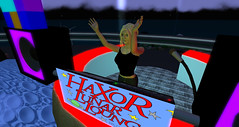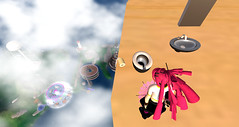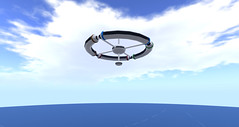Education used to be fun. We all remember that one great teacher that turned us on to some topic or at least made it fun. Somewhere along the way, education and learning became somewhat separated. Not intentionally, but as a result of some who wanted to make it better, and who genuinely thought they were making it better.
In the U.S. we saw the development of Federal policy where “teaching to the test” overrode teaching for the sake of education. This is a gross generalization to be certain and chances are that if you have been reading Ener’s blog posts on OpenSim you are not “that” kind of teacher. I would bet that you are the type of teacher that students will remember and the type of teacher that truly believes they do make a difference. And you do.
 Using OpenSim is a skill set that you do not need to have to be a teacher. No teacher certification depends on your ability to teleport or terraform. If you are a teacher reading this post and actively involved in using virtual worlds, or just starting to explore them as a possible tool, take a moment to acknowledge that you care and that your passion pushes you to knock your head against the virtual wall. Learning to use virtual worlds takes effort but it can also be fun. And that is the key isn’t it? Learning can also be fun.
Using OpenSim is a skill set that you do not need to have to be a teacher. No teacher certification depends on your ability to teleport or terraform. If you are a teacher reading this post and actively involved in using virtual worlds, or just starting to explore them as a possible tool, take a moment to acknowledge that you care and that your passion pushes you to knock your head against the virtual wall. Learning to use virtual worlds takes effort but it can also be fun. And that is the key isn’t it? Learning can also be fun.
OpenSim allows you to create learning activities for your students and allows your students to learn using a very different and rich medium. Depending on your school, resources, students and their resources you can do many things with OpenSim. From assigning projects where students build their own objects or worlds to creating simulations to making large scale models of molecules or even of the human heart that you could walk through. These types of possibilities are why you read all that you can on OpenSim and spend your own time learning it. The biggest limit is your time because, if I have judged you correctly, you have more ideas of things to do with OpenSim than you can possibly create.
Virtual worlds are now on the upswing according to Gartner and decisions like Linden Lab just made about eliminating their educational discount is causing a stir in educational communities. Some of you saw the possibilities of virtual worlds a few years ago but could not take advantage of them because of cost and access. Now with the fresh activity of news you may just be learning about OpenSim and seeing that it is much easier to explore than Second Life ever was. If you have not had a chance to explore OpenSim, maybe try OpenSim on your own. Ener has done a wonderful job talking about running OpenSim on a USB drive, right down to even discussing a very reasonably priced drive that works very well (I now also use the Patriot USB drive and it works very well). The passion that Ener has is only hinted at with the iliveisl blog and what you don’t see are the hours spent exploring things like “sim on a stick” so that an honest and down to earth assessment of it can be made and presented to you.
 That same passion is being expressed in our endeavor of Enclave Harbour. We are exploring OpenSim as a contextual learning instrument. True contextual learning involves real places with real meaning to students. For example, contextual learning goes beyond learning that kinetic energy can be harnessed by turbines to create electricity to looking at the world around you and recognizing that there are many mundane instances of kinetic energy that could be harnessed. In the traditional teaching of turbine-generated electricity you could discuss wind turbines, hydro-electric plants, nuclear energy, and tidal and wave power. Those are great examples but many don’t exist in the context the student is living in. They simply become something to learn that may not hold particular relevance and thus may be quickly forgotten.
That same passion is being expressed in our endeavor of Enclave Harbour. We are exploring OpenSim as a contextual learning instrument. True contextual learning involves real places with real meaning to students. For example, contextual learning goes beyond learning that kinetic energy can be harnessed by turbines to create electricity to looking at the world around you and recognizing that there are many mundane instances of kinetic energy that could be harnessed. In the traditional teaching of turbine-generated electricity you could discuss wind turbines, hydro-electric plants, nuclear energy, and tidal and wave power. Those are great examples but many don’t exist in the context the student is living in. They simply become something to learn that may not hold particular relevance and thus may be quickly forgotten.
Ener did a great job, right down to performing the math, in building an example of harnessing kinetic energy that many students are able to relate to – flushing a toilet! In true Ener fashion, this commode is atop a building that is one metre taller than the current tallest building in the world.
When I taught private school, I might have hesitated using that example because of the ensuing chaos that would erupt in class (students making jokes for days, jumping off the virtual building, and other things that I am sure I would need to explain to principals and parents – but after blowing the light covers off a few times with experiments, these activities just get chalked up to “oh that Mr. Miller . . .”). Actually, I would have loved that example and love it when students get so excited about an idea that they run with it, even in silly directions. Some of the silliest things lead to the most serious of scientific discoveries (like harnessing the power of wastewater from high-rise buildings!).
My contention (and seemingly distant Ph.D. rides on this) is that a virtual world, such as one created with OpenSim, can lead to effective contextual learning. Having “physical” places created in a mixed urban and rural setting, such as Enclave Harbour, helps students see how connected these things truly are. This immersion makes learning fun for both educator and student and is, in my opinion, effective contextual learning.
Anything that you build in OpenSim represents something in the real world, at least in the mind of others experiencing it. Even if what you build is pure fantasy, such as a floating night club. You look at the object, maybe even walk around in the object and your mind tries to correlate it to a real object – it tries to place it into context – a context that you can see yourself in.
 As another example, Ener is working on a space station to explore various topics taught as cycles – such as the water, carbon, and nitrogen cycles. As soon as you enter a closed system like a space station, your mind starts to wonder “what if” and you can more easily understand how these cycles are indeed “closed”. Then, in moving from the space station to the desalination plant, you can better understand the water cycle and our relation to it – the context of us, as humans, in that cycle.
As another example, Ener is working on a space station to explore various topics taught as cycles – such as the water, carbon, and nitrogen cycles. As soon as you enter a closed system like a space station, your mind starts to wonder “what if” and you can more easily understand how these cycles are indeed “closed”. Then, in moving from the space station to the desalination plant, you can better understand the water cycle and our relation to it – the context of us, as humans, in that cycle.
Contextual learning: it’s one of the many things that makes OpenSim fun for educators, the ability to create a context, and makes for effective teaching and fun learning for students by placing them in that context.
reposted from iliveisl
